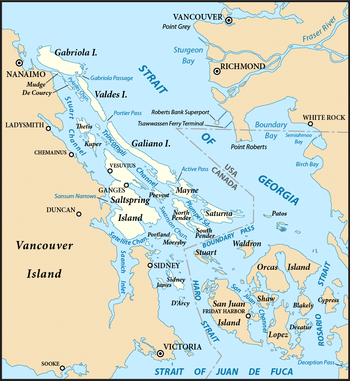One of the benefits of owning a boat in the Pacific Northwest is that you get to go whale watching for free. If you can find the whales, that is. Each year since we’ve owned Moonrise we’ve vacationed in the Gulf Islands and have been enchanted to see the pods of Orca whales that live in the area. We’ve seen Grey whales down closer to home, and Finback whales in the Strait of Juan de Fuca. When we were at Barkley Sound we saw Humpback whales; the thrill of a lifetime. We were really looking forward to seeing more whales on this trip. So the fact that almost the entire vacation went by without seeing any whales had me very frustrated and not a little pissed off at the whale gods.

Auklets, while adorable, are not the same as whales.
Mike has a certain affinity for whales and generally they are attracted to him. I believe he has a little whale song he sings under his breath and that they somehow know this and respond by coming close to us. My evidence for this is manifold, but suffice to say that the one day when he was literally the only boat in the bay and was surrounded by Orcas, who rarely venture down to Tacoma, I became convinced. This year, however, his song went unheeded. We kept watch all the time. We were constantly on the lookout for whales. Had we done something to displease the whales and their gods?

The archetype of the lighthouse keeping watch. This is Dungeness Spit, with porpoises in the foreground. We saw plenty of porpoises. Again, while marine mammals, these do not count as whales.
We had kept watch, we had yearned, we had encouraged each other to remain hopeful. “We’ll see whales today.”, we would say. All to no avail. Something had to be done. I had to pull out the “big guns”. We were leaving Narvaez Bay on the way to Point Roberts to check back into the U.S. I was lamenting the lack of whale action, especially as we had spent an entire day traveling down the Strait of Georgia looking for marine mammals of any size. It was apparent to me that a sacrifice was called for and since we had no virgins on the boat, I decided it was time for The Spitting. The credit for my knowledge of this goes to Cidnie over at Our Life With Ceol Mor who has mentioned this sacred feminine ritual to me on more than one occasion, albeit with tongue firmly in cheek. Many thanks for the info, Cidnie! Because it totally worked!

Mt. Baker and a lone paddler at Narvaez Bay on Saturna Island, one of our very favorite places.
As we motored out of Narvaez Bay I decided to take matters into my own hands regarding the whale gods. Rather than whine and beg them to accommodate me, their ears being completely deaf to pleadings of that kind, I decided to do a good ritual spitting into the sea and make a humble request.The way I look at it, I had nothing to lose. I believe it went something like this: “I spit three times into the sea and humbly request you allow us to see some of our whale brothers and sisters before our trip ends. You know how we love them. Thank you.”. I put the ‘thank you’ in there because it’s polite, which balances out the whole ‘spitting’ thing. Can’t get that far away from my upbringing.

This is a whale watching boat. Cool as heck! That’s Tumbo Island in the background. I believe this boat is from Victoria. But possibly Vancouver. Anyone recognize it? I was too busy watching whales to pay that much attention.
I kid you not, less than 5 minutes later we saw the Prince of Whales boat out of Victoria zooming toward us, a sure sign of whales in the vicinity. They were going our way and soon there was plenty of good whale action for everyone! Whales were jumping all over the place putting on a spectacular show in the tidal rips at the tip of Tumbo Island. It’s hard for me to get good photos of whales, especially as I’m generally jumping up and down on the bow of the boat yelling at poor Mike to ‘go that way!’. But we got our whale fix and we were grateful. They are so amazing.

A very lucky shot, especially with all the jumping up and down on the foredeck.

I would much rather see whales from my boat. But their boats are pretty cool. And fast. And the name cracks me up.

That’s the whale show for this year, unless Mike gets lucky again.
Until next year, my fine marine mammal friends! Many thanks for the excellent show! Next year I will cut to the chase and commence spitting upon arrival.






